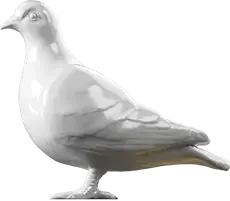Fashion — 1500-1599
Cap fragment
Fragment of brim of a woollen cap from the 16th century. The fabric was knitted in the round in stocking stitch on 4 or 5 needles, then fulled (washed, beaten and felted) and napped (raising and trimming the pile) to produce a stiff, hardwearing fabric. Knitted caps were worn by men in London's business and working communities in Tudor times. They were designed to be warm and waterproof. A range of styles and qualities were available to suit the taste and pocket of the customer.
The piece was bought by the London Museum in 1924 and no further find details are known. Workman in the early 20th century digging deep foundations for new buildings around the City of London found many pieces of clothing and textiles buried in the earth. Many are in a good state of preservation and may have been lost from wearers’ heads or discarded when they became unfashionable (from around 1570), thrown into the City ditch and cesspits. Unfortunately, because these were not formal archaeological excavations, any strata details or contextual material such as pottery that would help date the caps more closely were lost.
These caps are sometimes called ‘apprentice’ or ‘statute’ caps. In 1571 a statue was passed ordering every man over the age of six, except those of high rank, to wear a knitted woollen cap made in England on Sundays and holidays.
Some caps were trimmed with ribbons to imitate more expensive versions in silk. Wealthy Londoners wore headgear influenced by European fashions, and the bonnets (a cloth cap) from Milan, ornamented with ostrich feather plumes, aglets (metal tags) and brooches, were much in vogue.
TECHNICAL INFORMATION
The original cap from which this came would have been knitted in the round in one continuous working, using random decreases on the crown to achieve the round shape without spiral patterns of counted decreases. The fulling has made it very stiff, with no elasticity or ‘give’ at all. The feel is more like crisp felt than soft knitting. The woollen yarn has a hard twist to it, much more tightly spun than modern yarns. This gives the density of fibres that creates the very fine, dense, velvety nap remaining on some caps. Where it exists, the pile entirely obscures the knit loops underneath. The fulling can also make it difficult to determine the yarn spin direction.
Yarn - S spun, ? ply.
9 stitches per inch.14 rows per inch. Munsell Colour Value 10YR 3/2
Fine velvety pile present. The ground yarn is the same colour as the remaining pile, suggesting it was yarn-dyed or is the natural wool colour. Width 5 5/8 inches
- Category:
- Fashion
- Object ID:
- A26896
- Object name:
- cap fragment
- Object type:
- Artist/Maker:
- —
- Related people:
- Related events:
- Related places:
- Production date:
- 1500-1599
- Material:
wool
- Measurements/duration:
- W 150 mm, L 148 mm
- Part of:
- —
- On display:
- —
- Record quality:
- 100%
- Part of this object:
- —
- Owner Status & Credit:
Permanent collection
- Copyright holder:
digital image © London Museum
- Image credit:
- —
- Creative commons usage:
- —
- License this image:
To license this image for commercial use, please contact the London Museum Picture Library.
